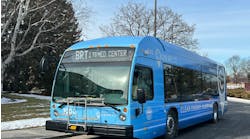Last week in Detroit, Sprint CEO Dan Hesse addressed the Detroit Economic Club explaining how Sprint intends to leverage its 3G and 4G wireless networks to bring ‘significant environmental, safety and operational benefits’ to the transportation industry. Through a Connected Transportation initiative, Hesse outlined a machine-to-machine (M2M) solutions strategy that would create products and services for mass transit operators and public safety organizations to improve driver performance, increase public safety and enhance fleet management logistics. By using such wireless technology, Hesse said, accident reduction of 5 percent in a 100-vehicle fleet could bring about six fewer accidents each year. That’s a compelling argument for M2M, and to help develop such solutions Sprint has opened an M2M Collaboration Center in the San Francisco Bay Area to work with device manufacturers and applications developers, get products certified and bring them to market. Sprint cites Amtrak as being just one transport organization already working with the carrier on applications such as Wi-Fi and digital signage connected over 4G networks to improve the travel experience. Connecting Vehicles With the global mobile M2M market expected to reach $57 billion by 2014, Sprint is not the only carrier looking to get in on the action. Cisco agrees that M2M is ready for prime time, and that automotive and transportation applications are high on the list, pointing to initiatives like Telenor’s Connexion as a leading example. In Europe, Nissan Leaf owners will be able check the battery status and control certain functions of their parked cars from mobile phones, via the Telenor network. Telenor believes that growth in this sector will be assisted by EU legislation such the Intelligent Transportation Systems (ITS) Directive 2010/40/EU which came into force in the fall of 2010, laying out a framework for deployment of road transport ITS solutions. It won’t be a fast path to implementation due to market complexity, warns Telenor’s Rémi Demerle, but legislation is what the industry needs to create a common EU standard for connected services to ground transport. The question remains whether a European standard would be adopted in North America. The GSM Association (GSMA) predicts that the worldwide penetration of telematics systems in vehicles will climb from less than 10 percent in 2010 to 23 percent in 2015; this can only be achieved with consensus among carriers and vendors on how that will be accomplished technically.
Not that all EU Connected Transportation ideas are good ones. In the news this week was the SARTRE project, which stands for Safe Road Trains for the Environment. The idea is that as you’re cruising along the freeway, your car can automatically join a convoy or ‘platoon’ where the lead vehicle takes control, and you sit back and enjoy a sandwich, take a nap, or — as I see it — end up in a god-awful raging fireball. I mean really, do you see this catching on in the U.S. say, on 405 in downtown L.A. during rush hour? No, didn’t think so. Volvo believes this will be the new way of traveling within ten years. Good luck with that. Connecting Passengers Regular readers will know that I often cover stories about Wi-Fi on passenger transport; I like to be connected on the train or bus, preferably on someone else’s nickel. The cost of deploying Wi-Fi on a fleet has dropped dramatically in recent years due to lower equipment costs, and overheads can be offset by a variety of business models. 2011 has got off to a good start with several transit agencies committing to public Wi-Fi on their vehicles. Los Angeles Metro issued a tender for the design and implementation requirements for Wi-Fi on the Metro Gold Line, which extends twenty miles between Pasadena and East Los Angeles and has a ridership of over 34,000 daily boardings. Issued by the Community Redevelopment Agency of Los Angeles (CRA/LA) it’s essentially an RFP for a consultant to write the final RFP, which CRA/LA hopes to issue by mid-year. Accordingly to consulting firm Senza Fili, which conducted an initial assessment of passenger Wi-Fi for CRA/LA in late 2008, additional ticket revenue resulting from a ridership increase of between 3-5% would be sufficient to cover both the initial CAPEX and ongoing operating expenses. Costs for an urban deployment can vary hugely depending on the technical approach; for example three years ago building a private trackside network using 5GHz WiMAX or Wi-Fi might have been the most sensible approach for delivering connectivity to a train full of eager Tweeters. But today, with the advent of 4G networks which are often quite dense in the urban core and capable of bursting to speeds in excess of 6-10Mbps, using commercial mobile networks becomes more of a viable option, particularly if you aggregate 4G carriers like Verizon and Sprint together to create a ‘bigger pipe’.
Proponents of trackside infrastructure often cite wireless CCTV and other bandwidth-hungry applications as justification of the cost and effort needed to build a network in the rail right-of-way (ROW). Tunnels can also pose a problem to 3G/4G cellular network coverage and Gold Line has several, including one almost two miles long. Interestingly in its tender CRA/LA has only specified passenger Wi-Fi as a requirement, and has around $1 million in grant funds to spend on the project. Meanwhile in Montana, Michael Tree hopes to spend slightly less to bring Wi-Fi to his passengers. Freshly installed as General Manager of Missoula’s Mountain Line bus service, he’s on a mission to bring new technology to his fleet, and Wi-Fi is near the top of the list. Operating fixed-route and paratransit services with 19 vehicles over a 39 square mile area, Mountain Line has seen a 60 percent increase in ridership in the last 15 years. According to Tree, 2010 came to close with another significant uptick in ridership; over 72,000 boardings in December alone. Around 40 percent of Mountain Line passengers are commuters equipped with smartphones and the smarts to use them. Tree hopes to have Wi-Fi available by June, while also adding GPS tracking and an SMS-based arrival time notification service. Unwired noted that Mountain Line publishes its route and schedule data in GTFS format, and makes it available to developers online — a move other agencies should follow. Tree did not disclose funding sources for the Wi-Fi project in his interview with The Missoulian, and I forgot to ask him in the phone call we had, but I’ll circle back later in the year to see how the project is going. Connecting Cameras For many transit authorities, CCTV is a key driver for investing in wireless. Mesh vendor Firetide has had success around the world with connecting remote cameras over long distances, with enough capacity to support high-resolution video. Following successful deployments with Seoul Subway in 2009 and Mumbai Metro in 2010, the company has returned to Korea with an ambitious project to remotely monitor dams and deliver public Wi-Fi access along a 240-mile, four-river corridor. Firetide CEO Bo Larsson expects transportation to be one of the fastest growing markets for wireless infrastructure used in video surveillance through 2014. While 4G is considered an option for remote video access, Larsson is quick to point out that a standard definition (SD) video feed needs 2-3Mbps of uplink bandwidth for continuous streaming, while 1080p HD video requires more than 5Mbps — not the type of capacity available on commercial 4G mobile networks.
In the Mumbai Metro project, Firetide mesh modes have been successfully delivering video over a 10Mbps network from trains traveling at 50MPH, while the company’s fixed mesh nodes can achieve speeds over 300Mbps outdoors using MIMO antenna technology for more ‘fiber-like’ performance. Firetide, along with other mesh infrastructure vendors such as Tropos and BelAir, offer more flexible alternatives to fiber and 4G with the ability to support multiple concurrent applications from moving vehicles. Fancy a Date? We really should stop meeting like this — in print I mean. There are a number of transport-oriented events coming up where you’ll likely find me and others from Mass Transit magazine, and you might just hear me speak on a panel or two. Here are a few to watch out for: PTC World Congress, February 22-24, Miami FL APTA TransITech, March 29-31, Miami FL IWCE, March 9-11, Las Vegas NV The first drink’s on you. Jim Baker is CEO at Xentrans Inc., a wireless project management consultancy based in San Francisco and London and a consulting editor for Mass Transit magazine. A C-level wireless industry veteran, Baker has been involved in many deployments of wireless technologies on passenger transportation worldwide and is a recognized industry expert on Wi-Fi, 3G and 4G convergence. He is chair of the Technology Committee at the Joint Council on Transit Wireless Communications that is developing a strategic plan for implementation of wireless technologies in mass transit. Contact Baker via LinkedIn or follow him on Twitter.


